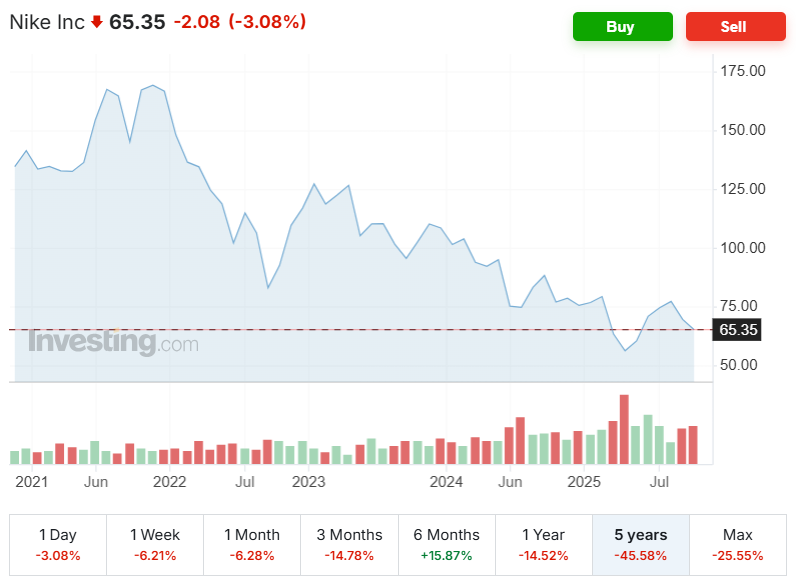
Sneakers with a Motor: Will This Innovation Bring the Desired Growth to the Declining Nike?
Once the leader in the sportswear and footwear segment, Nike is now experiencing a downturn as demanding consumers turn to products from strengthening competitors. To restore its former glory, the company has launched an innovation-driven project, including motor-powered sneakers. Nike’s CEO, Elliot Hill, believes that innovation is precisely what will get the company back on its feet.[1] Although he has been in charge for a year, his changes have so far been slow to show, which is ultimately reflected in the company’s financial results and stock market performance.
Sport for Everyone
The revolutionary innovation announced by the company at the end of October, part of the Project Amplify initiative, aims to bring to market the first motor-powered sneakers. Thanks to an ankle cuff with a rechargeable battery, leg muscles will experience less strain, allowing runners to cover longer distances. The device is recommended mainly for casual athletes, which, as Nike stated in its report, will make running, jogging, and walking accessible to everyone. The Nike Sport Research Lab, which is involved in the development, has partnered with the technology company Dephy, which has been working with bionic footwear and exoskeletons since 2016. This project isn’t entirely new for Nike either. As the company noted, it has been testing the accessory for several years, with about 400 athletes trying various cuff versions and together taking more than 2.4 million steps. Despite years of development, the innovation is still in its early stages, and the product may not reach store shelves for several years — leaving room for competitors to grow further in the meantime.
Futuristic Equipment
However, this innovation is not the only project within Nike’s portfolio expansion. More than a thousand employees participated in the creation of four platforms aimed at improving athletic performance. Besides Project Amplify, these include Aero-FIT and Therma-FIR Air Milano, which offer better thermoregulatory properties for apparel. The most intriguing is the final platform, Nike Mind. A decade-long development resulted in the Mind 001 and Mind 002 sneakers, based on neuroscience and designed to help athletes connect mind and body through sensory receptors. These will arrive in stores early next year. The initiative for such innovations came from Elliot Hill, who also introduced changes in the segmentation of apparel — now divided by sport rather than gender. In an interview with CNBC, he said he believes Nike has a way to grow again, though he admitted it will take some time.[2]
Other Brands Are Racing Ahead
While Nike is transforming, its competitors such as Hoka and On — both on the market for only about 15 years — continue to gain strength. For example, Hoka, owned by Deckers Brands, saw its net revenue rise 11% year-over-year in Q2 of fiscal 2026 to 634.1 million USD. The other, On, reported record sales of 749.2 million CHF (944 million USD) in Q2 2025, a 32% increase. Looking at Nike’s financial results, the company recorded a slight revenue increase in Q1 of fiscal 2026, even surpassing analyst estimates from LSEG. Revenue grew by 1% to 11.72 billion USD, but net profit partially overshadowed this figure, dropping 31% year-over-year. Although the latest quarterly results were better than expected, the outlook wasn’t as bright. With the busy holiday season approaching, the U.S. brand expects a slight decline. Despite restructuring and ongoing changes, tariffs remain a major concern. According to CNBC, Nike expects to lose around 1.5 billion USD in the current fiscal year due to tariffs.[3]
Stagnation on the Stock Market
An unfavorable outlook, underwhelming quarterly results, and customer defection have pushed Nike into the red on the stock market — both in the short and long term. The stock price has fallen by 6% over the past month and by 14.5% over the past year. Over five years, it has dropped by more than 45%. Some relief came in April 2025, when the stock value rose by about 15%, rebounding from a five-year low. As of October 30, 2025, shares stood at 65.35 USD.*

Source: Investing.com*
* Past performance is not indicative of future results.
[1,2,3] Forward-looking statements are based on assumptions and current expectations that may be inaccurate or dependent on the current economic environment, which may change. Such statements are not guarantees of future performance. They involve risks and uncertainties that are difficult to predict. Actual results may differ materially from those expressed or implied in any forward-looking statements.

